#Song dynasty (960–1279)
Text
[Hanfu · 漢服]Chinese Song Dynasty (960–1279 AD)Traditional Clothing Hanfu Reference to Song Dynasty Sculpture


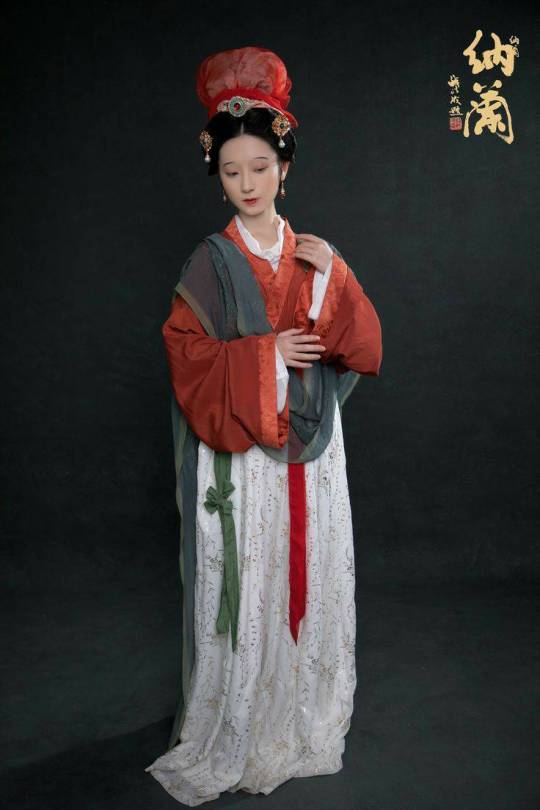

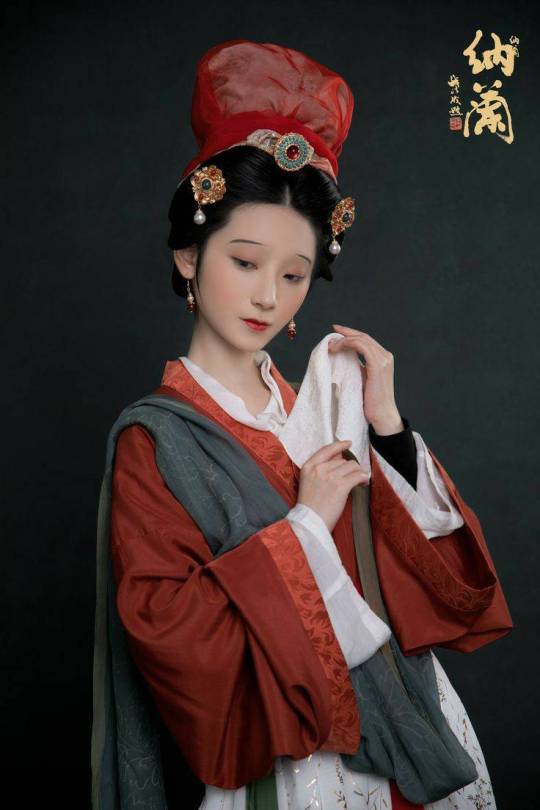
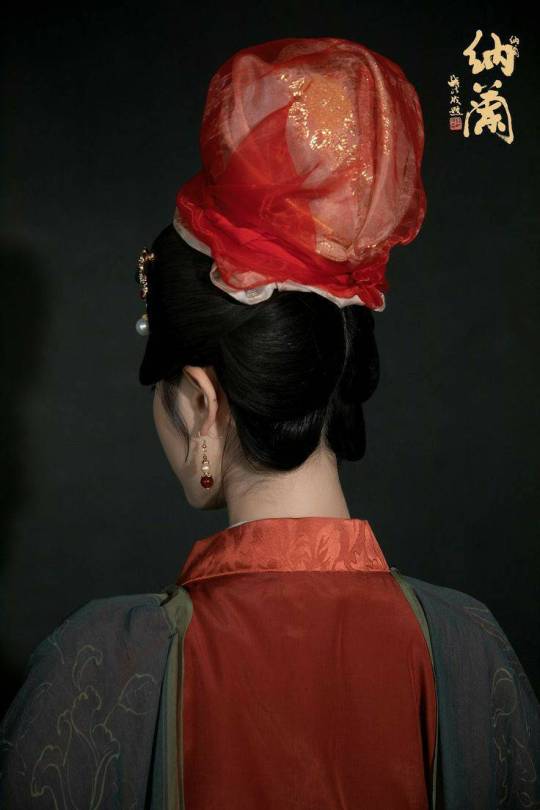
【Historical Reference Artifacts】:
China Song Dynasty Painted Sculpture from【Jin Temple】晋祠宋代彩塑
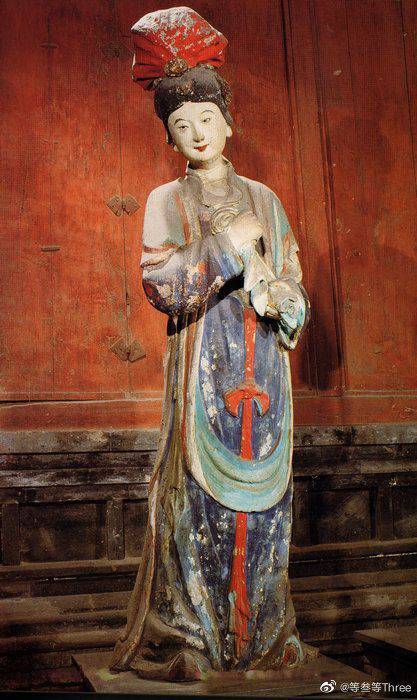
▶️【About Hairstyle“包髻/Bao Ji”】:
It is one of the hairstyles of ancient Han women.
包髻/Bao Ji is a hairstyles that use rectangular headscarf to cover the hair. When worn, it is folded diagonally, wrapped from the front to the back, and then wrapped around the corner of the scarf to the front of the forehead to tie a knot.
As early as the Tang Dynasty(618-907 AD), there was a prototype of this hairstyle, and it became popular in the Song Dynasty.
Women in the Ming Dynasty(1368-1644 AD) liked to use black gauze to make this hairstyle and this kind of hairstyle survived until the last dynasty of China: the Qing Dynasty.
#chinese hanfu#Song Dynasty (960–1279 AD)#hanfu#hanfu accessories#hanfu_challenge#chinese traditional clothing#china#chinese#chinese history'#chinese fashion history#chinese historical hairstyle#chinese art#漢服#汉服#中華風#包髻/Bao Ji#Jin Temple
208 notes
·
View notes
Text
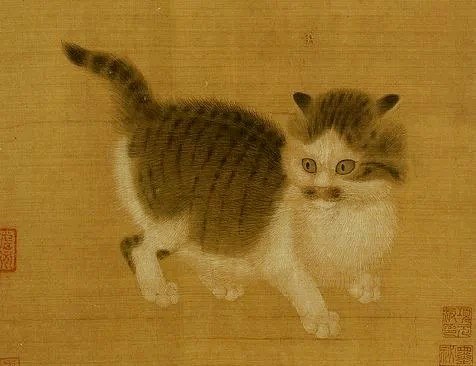
Kitten, fourth leaf in the album Li-tai Hua-fu-Chi (Album of Paintings from Various Dynasties), Song dynasty (960-1279), Collection of the National Palace Museum, Taipei, Taiwan
2K notes
·
View notes
Text


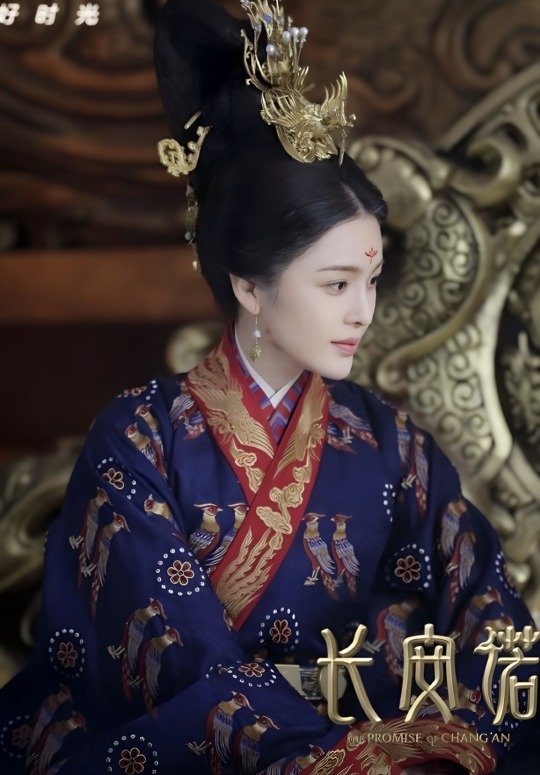



🦜 Diyi | 翟衣 🦜
Is a type of historical Chinese attire worn by empresses. During the Song (960–1279) and Ming (1368–1644) dynasties, it was considered the highest form of ceremonial clothing worn by the empress. It’s worn with Fengguan (phoenix crown). It was first recorded as “Huiyi” in the Zhou dynasty (1046–256 BC).
1st drama: Palace of Devotion 大宋宫词
2nd+3rd: The Promise of Chang’an 长安诺
4th+6th: Rebirth For You 嘉南传
5th: Serenade of Peaceful Joy 清平乐
#china#chinese culture#chinese history#cdrama#chinese drama#hanfu#hanfu restoration#east asia#fengguan#phoenix crown#song dynasty#ming dynasty#dynastic China#ancient China#Medieval China#art
156 notes
·
View notes
Text

Previously attributed to Wu Bing (吳炳, 12th c.), Song Dynasty (960–1279)
From ancient times, the lotus has been a divine symbol in Asian traditions. It is one of the Eight Auspicious Signs (Ashtamangala) pertaining to a number of Dharmic Traditions, such as Hinduism and Buddhism. In Buddhist symbolism, the lotus represents purity of the body, speech, and mind as if floating above the muddy waters of attachment and desire.
434 notes
·
View notes
Text
“How Often Does Such a Bright Moon Come Around?” (水調歌頭 · 明月幾時有) Translation
(Another year, another Mid-Autumn Festival, another poem translation. This particular poem is very famous because of the first and last lines, which are frequently referenced in popular culture. Happy Mid-Autumn Festival!)
How often does such a bright moon come around?
By Su Shi (Song dynasty, 1076 AD)
Mid-Autumn of the year Bingchen (2), drank all night in celebration, became heavily inebriated. Composed this poem to commemorate this occasion, and in dedication to Ziyou (3). (4)
How often does such a bright moon come around? With wine in hand, I ask the heavens.
Wondering what year it is for this day in heaven (5), in the palace high above.
Wishing to ascend on the wind, yet I cannot stand the chilly air around those lofty towers of jade.
Dancing and amused at my own crisp shadow, the frigid heavens surely cannot compare to the mortal realm below.
Rounding the vermilion building, hanging low near the intricate windows, the moon casts light over the sleepless (6).
The moon should not feel bitter jealousy, so why is it only full on parting?
Humans feel grief and joy, partings and reunions, just as the moon waxes and wanes.
For both of these heartening things (7) to happen together is very rare indeed.
May we be blessed with longevity, so that even when thousands of li (8) apart, we can still gaze upon this wonderful moon together.
—————————-
Notes:
This poem is in the Ci/词 format, and follows the rhyme scheme (Cipai/词牌) called Shuidiaogetou/水調歌頭/水调歌头.
Bingchen/丙辰 is a year in the Chinese Sexagenary Cycle, which is known in Chinese as Tiangandizhi/天干地支 ("Heavenly Stems and Earthly Branches") or simply Ganzhi/干支 ("Stems and Branches"), and is used to record time. This system has been in use since at least the Shang dynasty around 3000 years ago (oracle bone artifact bearing inscriptions of ganzhi has been found at Yinxu/殷墟, the archaeological site of the ancient capital of Shang dynasty; however, during Shang dynasty the Ganzhi system was used to track days and not years, unlike how it has been used in later times). Because there are 60 years in one cycle, it is possible to trace back to specific years. In this case, Bingchen would be exactly 1076 AD.
Ziyou/子由 is the courtesy name of Su Shi's brother, Su Zhe/蘇轍.
This section is a short introduction to the poem, which begins after this section.
This may be a reference to the concept that "a day in heaven is a year on earth" ("天上一天,地上一年"; famously included in Journey to the West), which in turn is a reference to the ecliptic plane (called Huangdao/黄道 in Chinese), since for an observer on Earth, the Sun appears to move in an elliptical path throughout the year. This means that it takes a year (i.e. "a year on earth") for the Sun to "complete" one round in this elliptical path (i.e. "a day in heaven").
Here, "the sleepless" is a reference to the poet himself.
"Both of these heartening things" refers to reunion with family and/or friend, and the occurence of a full moon.
Li/里 is a traditional unit of distance. During Su Shi's time (Northern Song dynasty, 960 AD - 1279 AD), 1 Li ≈ 576 meters = 0.576 km or 0.36 miles (Note: link leads to pdf).
—————————-
Original Text (Traditional Chinese):
《 水調歌頭 (1) · 明月幾時有 》
[宋] 蘇軾
丙辰中秋,歡飲達旦,大醉,作此篇,兼懷子由。
明月幾時有?把酒問青天。不知天上宮闕,今夕是何年。
我欲乘風歸去,惟恐瓊樓玉宇,高處不勝寒。起舞弄清影,何似在人間。
轉朱閣,低綺戶,照無眠。不應有恨,何事長向別時圓?
人有悲歡離合,月有陰晴圓缺,此事古難全。但願人長久,千里共嬋娟。
#mid autumn festival#midautumnfestival#chinese poem#poetry#how often does such a bright moon come around#my translation#明月几时有#苏轼
171 notes
·
View notes
Text
Today's apocryphal Sun Tzu quote
The sillier the lie, the more aggressive the liar - and then, silence.

Wei Sheng - Crape myrtle (sketched from life). Dates unknown, Song dynasty (960–1279, AD)
54 notes
·
View notes
Text

This gold pendant takes the shape of a water drop. It is crafted by joining two openwork gold sheets that have identical decorative patterns. Each sheet features a chrysanthemum on the uppermost part, and a phoenix soaring from the bottom amidst camellias and peonies, creating a harmonious floral artistry.
This pendant was discovered strung to its female tomb owner with silk thread. It is believed to be a pendant hung from women’s long shawl, unraveling the grace of Song Dynasty (960-1279) noble attire. It is in the permanent collection of the Nanjing Municipal Museum.
Courtesy Alain Truong
46 notes
·
View notes
Text
Jiǔwěihúlí/Jiuweihuli - The Nine Tailed Vixen
By the way; Wukong in "The Monkey King and the Infant"/TMKATI au isnt the only monkey getting an adoptive parental figure >:3
Went down a little of a Huli jing rabbit-hole after recieveing this ask from @dorothygale123:
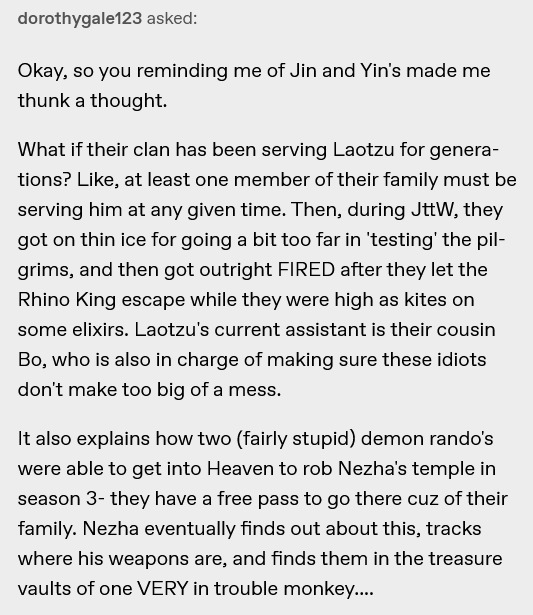
And while researching Jin and Yin in the book, I realised some stuff;
In "Journey to the West", the Jin and Yin's mother is frequently described as "aged/old madam", making it likely that she had them in the demon equivalent of middle-age.
Here's the poetry Wukong jots down (he does that alot in the book) when he sees her for the first time;
"Snow-white hair all tousled,
And starlike eyes all aglow.
Her face, though ruddy, has many wrinkles;
She‟s full of spirit though few teeth remain.
Charming—like the frosted chrysanthemum;
Rugged—like an old pine tree after rain.
A scarf of fine-spun white silk wraps her head,
And bejeweled gold rings hang from her ears"
For some odd reason, the monkey cries at the sight of her (his excuse being that he has to bow to her while disguised as a servant). Then he abruptly bonks her and her servants while travelling before stealing her divine Binding Gold Rope and disgusing himself as her to trick her sons. And of course the whole Calabash incident happens, the boys uncle calls down an army of fox demons to fight the pilgrims, and Lao Tzu has to show up and smack his lab assistants across the head.
Which leaves the question... how does Lao Tzu know the kids of a random fox lady???
Well you see, in the Han-era (206 BCE - 220 CE); Xiwangmu was often depicted with a white-furred Huli Jing among her ladies-in-waiting. But any worship of fox-deities was out-lawed in the Song dynasty (960 CE - 1279 CE) due to a cult religion that worshipped Su Daji (of the "Investiture of the Gods/Fengshen Yanyi" fame).
So my idea for Jiuweihuli in the extended LMK-verse, is that she's was once Xiwangmu's og bestie, even long before the celestial tigress became Empress. The fox being among many chaotic and infernal spirits in the future Queen Mother's posse.
Upon the abdication of Yuanshi Tianzun as the Divine Emperor; Jiuweihuli would assist the future-Jade Emperor in his ascension to the throne, gaining her the titles "Dragon-Crushing/Supressing Vixen" due to her defeating multiple draconic rivals in battle.
For many centuries, Jiuweihuli and her family were welcome members of the Imperial Court. The older vixen having a position almost equal to a head consort despite her and the Emperor not having such interest in eachother.
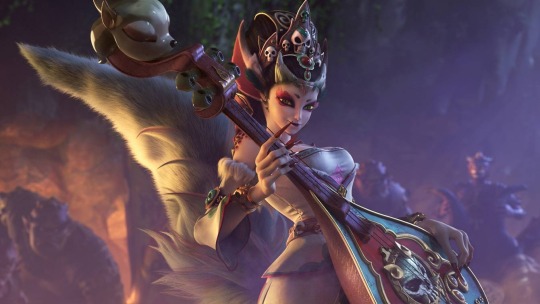
Then the Investiture crisis happened...
Within years, all that Jiuweihuli had built in the Celestial Realm crumbled. The actions of Su Daji soured opinion of the Celestials towards all fox spirits. Jiuweihuli was forced to be exiled from the Jade Palace down to Earth to prevent her being killed in an angry mob.
Penniless, alone, and with only her trusty pipa to her name; Jiuweihuli would travel and sing.
Eventually she gained a reputation as a grand preformer, drawing in audiences and tudis alike. Most of her trainees were unaware of her true nature, and those who did kept it quiet - drama kids loved the tragedy of the vixen's tale and would sing it throughout opera houses.
And one day, some time after the Monkey King tore through Heaven; Jiuweihuli gained a very unusual apprentice.
Jiuweihuli, sitting at her vanity table: "You look familiar."
Macaque, stepping out of the shadows: "I was once the attendant to Princess Iron Fan, but I believe both of our places in the court have been absolved."
Jiuweihuli: "Oh yeah, I went to that wedding. Had to wear a glamour. Is that Bull prince treating her right?"
Macaque: "He is. He was even willing to sacrifice his place in his own court for her."
Jiuweihuli: "Ah. Young love. But what brings you here?"
Macaque, sheepishly: "I uh... heard you were the person to go to if I wanted to learn how to preform professionally."
Jiuweihuli: "...your boyfriend's in jail, right?"
Macaque: "Uh, yeah?"
Jiuweihuli, getting up from her vanity table: "Good. 'Cus you're about to recieve many admirers."
Macaque: :'D!
You see, the older fox spirit knew she wasn't to be the "Vixen of the Stage" for much longer. She was already thousands of years old, and had found herself in the family-way by means of a romance gone sour. So when the dark, mysterious, and deadly beautiful Six-Earred Macaque showed up in her dressing room asking for mentorship? Jiuweihuli knew she had found her understudy.
With the Macaque taking on her most famous roles, Jiuweihuli was able to focus on raising her twin sons; Jin and Yin. Macaque often found himself dragged into babysitting the little terrors by the maternal fox, even if he had to admit their thieving skills were very good. The vixen in turn would protect the monkey from more imposing audience members/fans and encourage his more sarcastic humor.
She was of the shoulders Macaque cried upon when him and Wukong had their falling out.
Eventually the vixen managed to get into contact with an old... "friend" (the twins gag at the thought) Lao Tzu to provide the reckless boys some decent education.
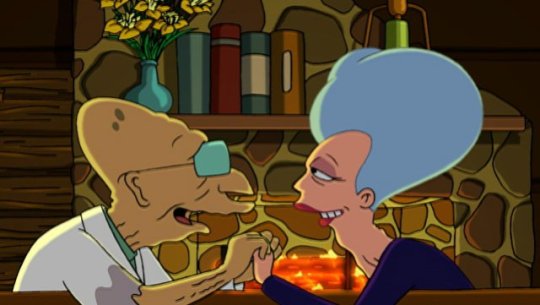
Aaand of course Wukong had to show up centuries later and cause havoc for the fox family when the twins got a little wild with their teacher's stash/artifacts. Luckily Jiuweihuli's brother, Hu A'qi, managed to smooth things over with heaven and offered his studious daughter as another lab assistant to keep the boys in check. Jiuweihuli, cleaning her wounds, sent a letter informing Macaque that his "idiot boyfriend" was out of jail...
Jiuweihuli soon lost her understudy.
The shadow monkey too blinded by anger to consider who would have to pick up the pieces if he failed. Jiuweihuli would eventually go on to teach a hundreds of aspiring actors and musicians, but she always would mourn for her little shadow.
Cue the events of "The Monkey King and the Infant" where Macaque begins frequenting and eventually working at the Megapolis Threatre House. He recognises not only his Brotherhood-era friend Jade-Faced; but a certain old master of his...

Jiuweihuli: "Do I know you?"
Macaque: "I should hope so. I was your understudy for many years."
Jiuweihuli: "I've trained hundreds of understudies, hon."
Macaque: "You trained me during the Tang-era? I could manipulate the shadows?"
Jiuweihuli: "Doesn't ring a bell." *sly smirk*
Macaque, realises she's messing with him: *sigh* "My idiot boyfriend hit you on the head with a cudgel and I stupidly ran after him and got killed."
Jiuweihuli, dropping the act: "Mihou! My little moonlight! Oh how I've missed you!" *gives him a big lipstick-stained smooch on the cheek*
The old vixen is very protective of her understudy now that she has him back. Her motherly side really comes to the surface when she's interacting with the shadow monkey, even if her interactions with her biological children isn't as soft. Jin and Yin get a slap of her sandal more than a few times for their foolishness.
If she learns that Macaque has a kid/kid on the way, Jiuweihuli is going full Grandma-mode. She's always considered her understudy as equal to her own kits and now he's all grown up!! (╥ ω ╥)
And you better believe a certain Monkey King is getting his ass kicked by an old lady the second Jiuweihuli learns he's around.
#the monkey king and the infant#the monkey king and the infant au#liu er mihou#six eared macaque#lmk aus#jiuweihuli#Jiǔ wěi húlí#lmk character ideas#lmk jin and yin#lmk gold and silver demons#lmk backstory hcs#nine tailed vixen#lmk jiuweihuli
25 notes
·
View notes
Note
We know that Erlang saved his mother and reunited with her. However, in other versions, he fails and his mother dies. At what point did this version of the story become known or what are the first versions where Erlang fails to save her?
Well, it is kinda a complicated answer.
Elang has the famous story of him carrying the mountain and chasing the sun which came around the Song Dynasty around 960-1279. The story actually doesn't start with Erlang saving his mother, until the Ming dynasty 1368 - 1644 that which was connected to saving his mother. It was Erlang Baojuan where it brought up the tale of Erlang Shen splitting the mountain to save his mother, which was connected to the existing tale of Erlang chasing the suns. But in this tale his mother was actually attacked by Sun Wukong and that is why she was under the mountain and in this version, Erlang Shen is the one to put Wukong under a mountain in revenge. This could be where Erlang's mother being injured from being under the mountain comes from.
"Erlang Baojuan" tells a complete story: Yunhua, the mother of Erlang Shen, was pinned down by the monkey pilgrim at the foot of Mount Tai. Erlang Shen received the advice of the Queen Mother and carried the mountain to chase the sun in order to save his mother. He then split the mountain to rescue his mother, but her mother did not wake up. Erlang Shen also collected medicines and made elixirs, and boiled elixirs and holy water for his mother to take. Only then did his mother wake up and mother and son reunited. In order to avenge his mother, he pinned the pilgrim under Mount Tai." -baidu page
So this is more drama in another version, even if it doesn't work chronologically speaking with the Wu Cheng'en's Xiyouji canon but honestly speaking I think that there is just so many versions where Erlang's mother doesn't survive because of the 宝莲灯前传 Lotus Lantern Prequel that slightly changed this story as well. This show has it that Erlang does save his mother in the end, however, the Jade Emperor sends his ten sons to kill her, which they do. Erlang in his anger shoots down nine of the ten suns, connecting to his chasing the suns legend, but is stopped before he can kill them all. So kinda that Erlang killed his cousins to avenge his mother.
I could be wrong and this is also another version that I just cannot find out written anywhere before Lotus Lantern Prequal but if I'm wrong please someone correct me. Otherwise, the best I can say is that Erlang's mother dying is just more of a popular headcanon in the community (similar to Bailong being called Ao Lie) that other directors and producers have taken up on in other pieces of media.
#anon ask#anonymous#anon#jttw#sun wukong#journey to the west#ask#erlang shen#yang jian#lotus lantern#lotus lantern prequel#again I'm just going off what I can read in articles#if anyone has a link to where the suns killed Erlang's mom that isn't after 2009 when the lotus lantern prequal came out I would love to se#it otherwise that is the best reason i can think why they keep killing her off in her more modern interpretations.#I only know of like a few erlang shen moves and sometimes she lives sometimes she dies but they were all after 2009 so i cant say how#accurate it is I can't find anything on baidu at least about her not dying and anything online just connects her dying with the lotus#lantern version of events
17 notes
·
View notes
Text
Reading notes – Slavery in Medieval China
Okay, so reading fanfics, I had a lot of ‘wait a sec, is this historically accurate?’ moments around QJL, so I did reading and…
Tang dynasty law: A master who killed his slave with no provocation whatsoever was sentenced to one year of penal servitude…
Under no circumstances were male slaves to be allowed to marry the daughters of commoners. Masters who permitted such unions to take place were liable to two and a half years of penal servitude, and the marriages themselves were to be annulled.
Me: … damn.
This is from Slavery in Medieval China (Chapter 11) - The Cambridge World History of Slavery btw.
Anyway, quick notes
I honestly don’t think fanfic (or just fiction in general) needs to be historically accurate (the cultivation world just isn’t, svsss world really isn’t) but this is here for anyone curious.
Big disclaimer: Any mistakes are probably my misunderstandings. Take everything with a pinch of salt. You have been warned. (Also if anyone knows more about this/has corrections, please tell me. *puppy eyes*)
Essentials
Since the Zhou dynasty (1045 BC – 221 BC), there has been the notion of liang or ‘good’ people and jian or ‘base’ people. Slaves were seen as a subset of ‘base’ people. Other ‘base’ people included convicted criminals and their descendants (who could be made into slaves). So there was an idea of slavery being punishment, and slaves being ‘deserving’ of their status. (Although by the Song dynasty (960-1279) the distinction between ‘good’and ‘base’ seems to be more based on occupation. For example, prostitutes were seen as ‘base’.)
There were two main types of slaves 1) official slaves owned by the government. 2) private slaves (SJ falls under this category). Legalities and stuff were different for the two categories.
Legalities
Slavery was legal. So no, QJL would not be punished/criticised in general for owning or purchasing slaves. (Although apparently Emperor Hongwu (1328-1398) of the Ming dynasty did try to abolish private slaves, without success.)
On the other hand, while slavery was legal, the method of procuring slaves was often not. In the Tang dynasty, technically the only legal way for a (Chinese) freeperson to become a slave was to sell themselves (which was common practice for the desperate), but many slaves were those kidnapped by groups of traders. Kidnapping a ‘good’ person and selling them into slavery was punishable by strangulation (which reflects the attitude that ‘good’ people were different from ‘base’ people and didn’t deserve the same treatment). Kidnapping foreigners was also popular, since they weren’t protected by the same laws as Chinese citizens. There were edicts conedemning and forbidding the practice but to little effect.
So maybe the slave traders could be condemned, and maybe if it could be argued that QJL knew they were shady he could also be condemned, but I have a feeling it wouldn’t be that serious a thing.
Treatment
Before and during the Northern and Southern Dynasties (420-589) owners of slaves could treat them in any way they liked, even if it resulted in maiming or death, with no consequence.
In the Sui (581-618) and Tang (618-907) dynasties, slaves had a few more rights. A master wasn’t allowed to just kill their slave (you needed government permission) but if it happened, it would be either punished with a beating, or one year of penal servitude (if the killing was unprovoked). In the Ming dynasty (1368-1644), the punishments were the same, but if the killing was unprovoked, the slave’s family would be freed.
Wikipedia informs me that in premodern China (??? When even is this), punishment and abuse of slaves was regular but was rarely reported or looked into. But it could be, if the master was being investigated for other crimes.
On the other hand, a slave threatening or harming their master was seen as a severe crime. In the Tang dynasty, even plotting against one’s master was punishable by decapitation, whether the attempt was successful or not.
So SJ is unlikely to have been seen favourably for what he did. The only way I can see this being turned around is if SJ’s status as a peak lord and reputation is enough for everyone to see him as a ‘good’ person, and then there might be outrage at his treatment.
Marriages
During the Tang dynasty, marriages between enslaved men and free women was illegal and very taboo. (But there was nothing preventing a free man from marrying an unfree woman.)
However for premodern slaves, Wiki gives me this: After their servitude, male slaves were either released from the main house to survive on their own, or they could have marriages arranged for them if their masters considered them to be extremely loyal or hard working. Those who were chosen to be married would be provided with an 'unlucky' woman, usually a person with disabilities or the daughter of another slave.
So QJL allowing SJ to marry QHT would have been extremely unusual. It would definitely have turned heads. People would probably have thought that either he was extremely fond of SJ, or he hated his sister. And since SJ was outwardly treated fine and QJL clearly loved his sister, they’d probably have assumed the former.
On the other hand, there was also a tradition of buying male slaves to become heirs, and they would become family. No source but adopting sons seems to be a big thing in Asia??? (Cao Song, father of Cao Cao, was the foster son of Cao Teng, a powerful eunuch at the time. There's also Matsudaira Katamori, a daimyo of the Bakumatsu period, who was also adopted.) It also just seems to be a thing where if a family has no sons, they go find a good marriage for one of their daughters and the son-in-law becomes the heir. WYZ remarked that QJL was SJ’s brother – this could refer to SJ’s (future) marriage to QHT, or maybe (???) it could be his position within the household as an adopted son of sorts???
Slave contracts
I have a feeling SJ’s situation is closer to premodern slaves than to medieval slaves, and for that we have a section (on wiki) on slave contracts: The contract stated the name of the person offering the slave, the name of the person buying the slave, the name of the selling agent, the name of the guarantor, the age of the slave and how many years the slave was to work for the new family, which was typically around 10–15 years.
Tl;dr QJL could not be punished for keeping or purchasing slaves. But – depending on the era you want to base the cultivation world in – had he outright killed SJ, he could have been (lightly).
45 notes
·
View notes
Photo

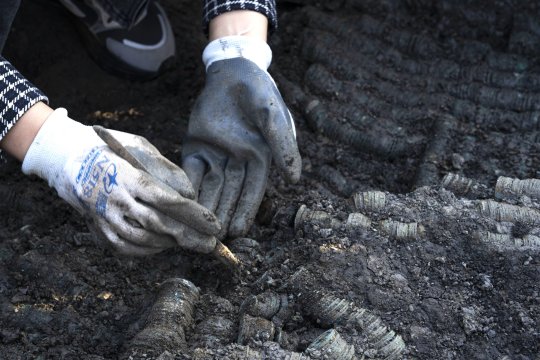

1.5 Tons of Ancient Bronze Coins Found in China
A massive hoard of 1.5 tons of bronze coins dating to the Tang (618-907) and Song (960-1279) dynasties has been unearthed in the village of Shuangdun in eastern China’s Jiangsu province. The coins were strong together with straw ropes and arranged in tidy stacks.
The uncovered coins were well-preserved, and most of them had clear inscriptions, suggesting important value for further research.
In ancient China, such hoards were often buried in the ground so as to preserve precious porcelain, coins, metal tools, and other valuables, said the researchers.
Seventy wells were also found around the coin hoard, which was near the battle frontline of the Song and Jin troops, making the researchers wonder whether the excavation site belonged to a hutted camp.
Most of the coins in the hoard are from the Song dynasty wens. Bronze wens were the common currency of the period until a severe copper shortage forced the Southern Song dynasty (1127-1279) to issue coins of lower quality and value. Iron was hard to mint and rusted too easily once in circulation. Due to the scarcity of bronze coinage, the government was forced to cut military wages in half in 1161, ultimately leading to the emergence of paper money. In 1170, the state began to require that half of all taxes be paid with Huizi paper currency stepped into the breach.
#1.5 Tons of Ancient Bronze Coins Found in China#Shuangdun#china’s jiangsu province#tang dynasty#song dynasty#coins#bronze coins#coin hoard#collectable coins#treasure#ancient artifacts#archeology#archeolgst#history#history news#ancient history#ancient culture#ancient civilizations#ancient china#chinese history
85 notes
·
View notes
Text
[Hanfu · 漢服]Chinese Song Dynasty (960–1279 AD)Traditional Clothing Hanfu Reference to Song Dynasty Murals
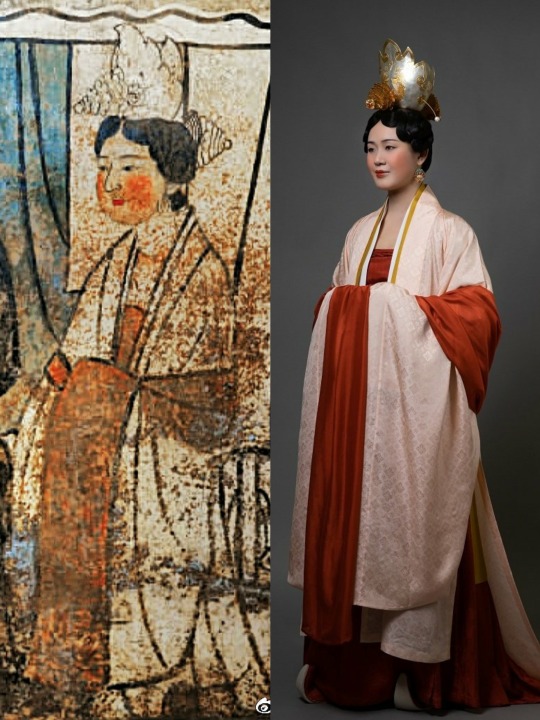


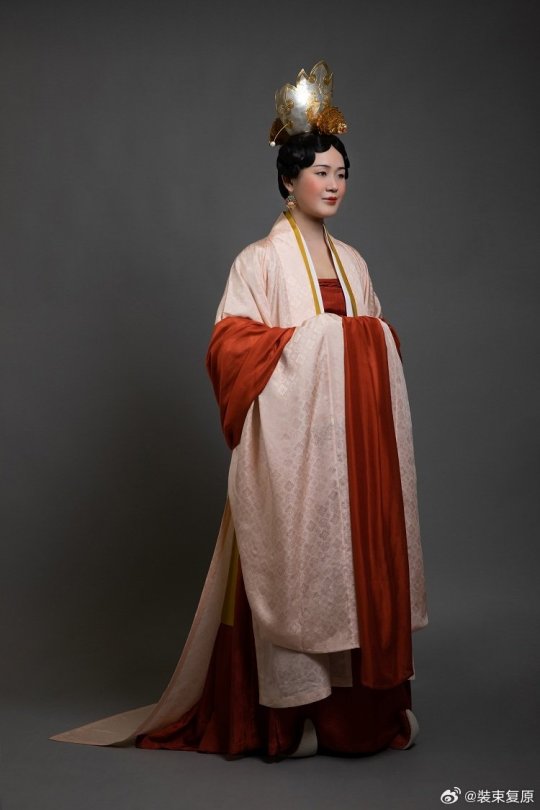
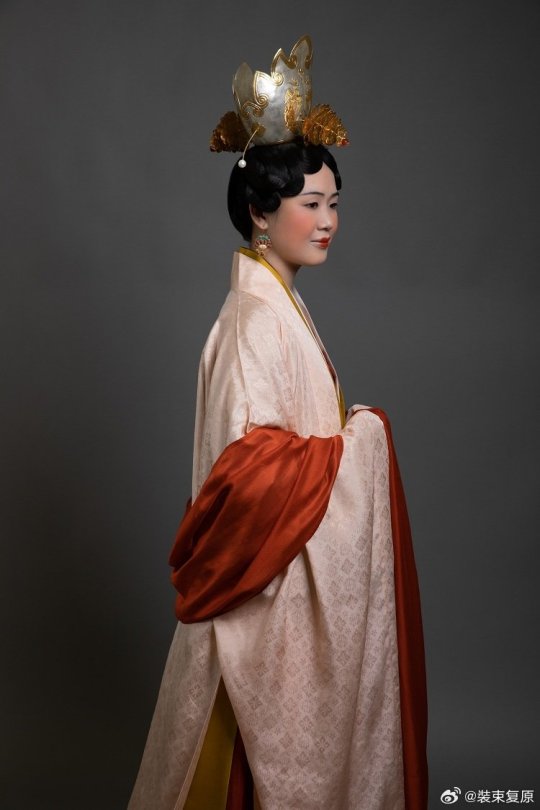
【Historical Reference Artifacts】:
Woman in the murals of the Song Dynasty tomb in Tangzhuang, Dengfeng, Henan,China.
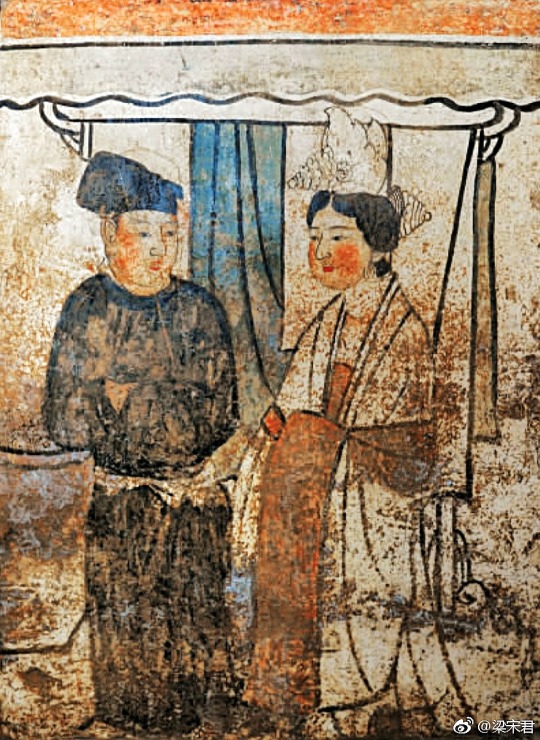

【Histoty Note】Song Dynasty (960–1279 AD)·Woman Formal Garment
The large-sleeved shirts and skirts of the Northern Song Dynasty were based on the long blouses and skirts of the late Tang and Five Dynasties, and became more refined and gradually became more ritualized. At the same time, the trend of women wearing crowns became more and more popular, and a variety of crown styles and matching hairstyles were developed.
The restoration of this outfit refers to the image of a woman in the murals of the Song Dynasty tomb in Tangzhuang, Dengfeng, Henan: her head is combed in a bun, with clouds shape hair around her temples, and a crown, which is fixed with flower hairpins on the front and back, and pearl hairpins on the left and right; Wearing a sleeved blouse, a long skirt, and a silk scarf was the attire of the common people and women attending formal occasions at that time.
At that time, married women often wore crowns, long-sleeved shirts and skirts, and shoulder-wrapped scarf when attending formal occasions or when common women got married. It gradually developed into a classic paradigm, which had an impact on popular fashion and the system of public service.
The "golden crown and xiapi金冠霞帔" that often appeared in literary works of the Song and Yuan Dynasties was developed from this classic ceremonial attire.
________________________________
📸Recreation Work:@裝束复原
🔗Weibo :https://weibo.com/1656910125/NdlVDn8JP
________________________________
#chinese hanfu#Song Dynasty (960–1279 AD)#hanfu#hanfu accessories#hanfu_challenge#chinese traditional clothing#china#chinese#chinese historical fashion#chinese history#hanfu history#漢服#汉服#中華風#Woman Formal Garment
191 notes
·
View notes
Photo
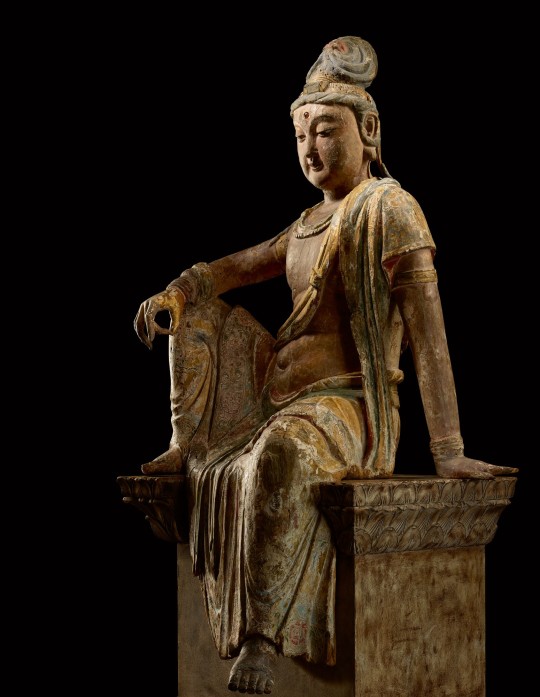
Wood sculpture of Avalokiteshvara
Song dynasty (960-1279)
height: figure 137.2 cm, overall 178 cm
229 notes
·
View notes
Text

Made in (13th-century) China
This tiny sleeping elephant was carved from jade and is only about 4 cm (1.5 inches) high and 9 cm (3 inches) wide. It was made towards the end of the Song Dynasty (960-1279). Such carvings are notable for their detail. In this example, the artist has depicted the elephant right down to its toenails. And can you spot the two nostrils at the end of its trunk?
Materials: Celadon, Jade
Date: 12th or 13th century
Origin: China
From the <cue ominous music> Arthur Sackler collection
Now in the Smithsonian National Museum of Asian Art, S1987.813
17 notes
·
View notes
Text
The Water Maiden
by LissyArt101
A Gruvia Fairy Tail Fanfic “Historical East Asia” AU
--
“Find him!” The loud shouts were loud enough to wake up the whole town.
“They’re looking for you,” he sighed, closing the window.
“So why don’t you tell them I’m here?” a voice said from above him.
Her focus shifted to Gray, and a soft smile spread across her face. It was a different kind of smile than the one she had given to Natsu’s and Lucy’s hug. It made him want to stare at it all day.
He was trying to get them out of the kingdom, but in his hurry, he forgot to check if anyone was after him. He was completely out of strength, his pursuers have caught him. His lost is consciousness feeling like he was sinking through the stone. The court official cursed, "Her world. Of course, he's in her world she's attracted to him."
--
Words: 2377, Chapters: 1/?, Language: English
Fandoms: Fairy Tail
Rating: General Audiences
Warnings: Creator Chose Not To Use Archive Warnings
Characters: Gray Fullbuster, Natsu Dragneel, Lucy Heartfilia, Juvia Lockser, Ultear Milkovich, Ur (Fairy Tail), Silver Fullbuster
Relationships: Gray Fullbuster/Juvia Lockser, Natsu Dragneel/Lucy Heartfilia, Natsu Dragneel & Gray Fullbuster, Lucy Heartfilia & Juvia Lockser, Natsu Dragneel & Lucy Heartfilia, Gray Fullbuster & Juvia Lockser
Additional Tags: Alternate Universe, Alternate Universe - Fantasy, Alternate Universe - Historical, East Asia, Asia, Song Dynasty (960-1279 CE), Original Mythology, Original Universe, Dragons, Goddesses, Gods, Magic, Alternate Dimensions, and more tags that I'll probably add later, Fluff, Fluff and Angst, Angst
Source: https://archiveofourown.org/works/53848204
3 notes
·
View notes
Text
Random Stuff #14: Cats in China--History (Part 2)
(Link to Part 1)
(Warning: Very long post ahead with multiple pictures!)
Cats Becoming Pets
In the book Dreams of Splendor of the Eastern Capital (《 東京夢華錄 》), a memoir by Meng Yuanlao/孟元老 about life in the then “Eastern Capital” or Bianliang/汴梁 (today known as Kaifeng/开封, located in Henan province) in Northern Song dynasty (960 - 1127 AD), there was a section called “Miscellaneous Goods”, which revealed that there were special street vendors who sold horse feed, dog food, and of course, cat food and cat treats:
“If you kept horses, there were two people who sold hay daily; if you kept dogs, there were dog food being sold; if you kept cats then there were cat food and small fish”. (“若養馬,則有兩人日供切草;養犬則供餳糟;養貓則供貓食並小魚”)
Another book that shed light on this change in more concrete terms is Fleeting Dreams of Splendor (《夢粱錄》)--which as you can probably guess from the title, is a memoir modeled after Dreams of Splendor of the Eastern Capital, this time about life in Southern Song dynasty (1127 - 1279 AD) capital city Lin’an/臨安 (today known as Hangzhou/杭州, located in Zhejiang province). In the book it was mentioned that people in the capital kept white or yellow long haired cats, called “lion cats”/獅貓, which couldn’t catch mice and were only kept for their looks, or in other words, these cats had become actual pets:
“People of the capital kept cats to catch mice, and the cats have long hair. Those that were white or yellow were called ‘lion cats’, these cats could not catch mice and were kept because they looked beautiful”. (“貓,都人畜之捕鼠,有長毛。白黃色者稱曰「獅貓」,不能捕鼠,以為美觀”)
During Song dynasty, folk customs also developed around cat adoption. Cat adoption, called pin/聘 or na/納, was treated like a “wedding” of sorts, complete with a “bride price” and a “marriage certificate” contract/契. The “bride price”, of course, was paid to the family that the cat came from, and usually took the form of some salt (this act is called ”bringing salt”/裹鹽; historically salt is a valuable commodity) or some small fish skewered on a willow branch (called “buying fish and skewering with willow”/買魚穿柳 or simply “skewer of willow”/穿柳). The contract, however, had quite a mysterious air about it and vaguely resembled a Daoist talisman:

^ Template of a cat contract, from Yuan-era (1271 - 1368 AD) book Newly Published Reference on Ying Yang and Selection of Dates/《新刊陰陽寶鑑剋擇通書》. Top says “Cat Contract”/貓兒契式. Content consists of a drawn picture of the cat in question at the center, and the terms of the contract written in a counterclockwise order that spiraled outwards from the picture of the cat, which read:
“A cat is Black Spots¹, it used to live before the bodhisattvas of the West, Sanzang² brought it home with him, and it has since been protecting Buddhist scriptures among the people. The Offeror is Moujia³ , who is selling (this cat) to a certain neighbor. All three parties⁴ has agreed upon the price of __, so __ will be returned as the contract finalizes. May the Offerer become as wealthy as Shi Chong⁵, and as long-lived as Peng Zu⁶. (From now on, the cat) Must patrol the grain storage diligently, and must catch rat thieves without slack. (The cat) Must not harm the chickens and other livestocks, and must not steal any sort of food. (The cat) Must guard the home day and night, and must not wander to the east or west. If (the cat) breaks these terms and wanders off, it shall be punished in the courtyard. __ year __ month __ day, Offeror __.”
The foot of the contract read:
”To evaluate a good tabby cat: there must be stripes on the body, and the stripes on the limbs and tail must be just right”⁷
“King Father of the East⁸ see to it that (this cat) does not wander south”
“Queen Mother of the West⁸ see to it that (this cat) does not wander north”
“Received on a day blessed by the Eminent Benefactor of Heavenly Virtues and Eminent Benefactor of Lunar Virtues⁹”
“Returned on a day blessed by the Eminent Benefactor of Heavenly Virtues and Eminent Benefactor of Lunar Virtues”
Notes:
“Black Spots”/黑斑: placeholder cat name.
Sanzang/三藏 refers to Xuanzang/玄奘, as in the real life inspiration of the character Tang Sanzang/唐三藏 in Journey to the West. It was widely believed that domestic cats had came to China from India with traveling Buddhist monks, and that they were protecting the scriptures from damage by rodents.
“Moujia”/某甲: placeholder human name.
“Three parties”: Offeror, Offeree, and Witness.
Shi Chong/石崇 was an extremely wealthy official during Western Jin dynasty (266 - 316 AD) who loved to compete with others over who was the wealthiest.
Peng Zu/彭祖 is a figure in legend and a Daoist immortal who had lived for 700 years according to legend.)
This is part of the practice of evaluating cats based on looks, called xiangmao/相貓.
King Father of the East/東王公 and Queen Mother of the West/西王母 are gods of Yang and Yin respectively.
Eminent Benefactor of Heavenly Virtues/天德貴人 and Eminent Benefactor of Lunar Virtues/月德貴人 are deities representing celestial objects, and are part of the Four Pillars of Destiny/四柱命理 concept in Chinese astrology, where basically different days and times are presided over by different celestial objects and therefore different gods. A day that is blessed by both of the aforementioned Eminent Benefactors is considered to be a very auspicious day.
As a cat owner, I could most definitely feel the helplessness and desperation emanating from this contract. Invoking deities in the hopes that the cat will do its job, not destroy stuff, and not simply run away......I’m sure many cat owners throughout the ages and across the world could sympathize with this sentiment. The special emphasis that was placed on keeping the cat from running away was probably because back then, people lived in residences that consisted of buildings surrounding a courtyard in the middle (for example, a siheyuan/四合院), so it was extremely easy for cats to run out of the residence and become lost.
Anyways......back to history.
Song-era poets wrote many poems about cats, and both Song-era and Yuan-era painters painted many works about cats (which I will cover in my next posts!). At the same time, cats were painted in Song-era tomb murals along with sparrows as a sign of longevity, since cats are māo/猫 and sparrows are què/雀, and when said together they sound like the word mào qí/耄耆, which means “elderly people”.
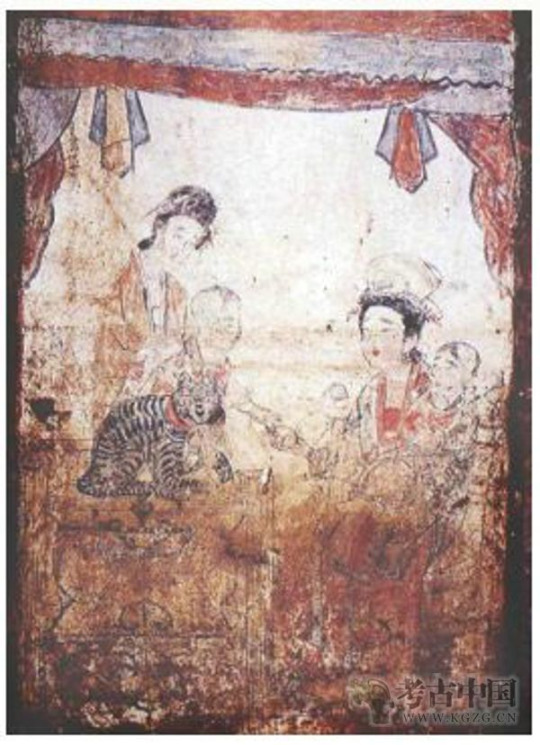
^ Tomb mural depicting a tabby cat with a sparrow in its mouth. From a Northern Song-era tomb discovered in Dengfeng, Henan.
Ming dynasty (1368 - 1644 AD) emperors were also big-time cat lovers. Of note were Emperor Xuanzong of Ming/明宣宗 (personal name Zhu Zhanji/朱瞻基), who painted cats, and Emperor Shizong of Ming/明世宗 (better known as Jiajing Emperor/嘉靖帝), who reportedly loved his cat Frosty Brows/霜眉/Shuangmei (I swear this name sounds a lot more artsy in Chinese) so much that he bestowed the title of Qiulong/虯龍 (note: Qiulong is a type of Chinese dragon that is either defined as horned or hornless depending on the source) upon it, and when Frosty Brows died, he ordered a tomb be constructed just for his cat, then ordered high-ranking officials to write eulogies for Frosty Brows:
“During Jiajing Emperor’s reign, there was a cat in the palace whose fur was slightly blue-ish except the glowing white brows, so it was named ‘Frosty Brows’. This cat understood His Majesty well, and when His Majesty went somewhere in the palace or visited a consort, it would walk ahead and lead the way. While His Majesty slept, it would stay nearby. His Majesty adored it the most. When it died, His Majesty ordered it be laid to rest at the shady side of Mt. Wansui (today called Jingshan/景山), and a stone stele was to be erected marking its grave as ‘The Grave of Qiulong’”. (嘉靖中,禁中有貓,微青色,惟雙眉瑩潔,名曰“霜眉”。善伺上意,凡有呼召或有行幸,皆先意前導。伺上寢,株橛不移。上最憐愛之。後死,敕葬萬歲山陰,碑曰‘虯龍��’)
-- Old Rumors Under the Sun, “Within the Palace of Ming Part 3″/《日下舊聞考·宮室·明三》
“Later when a lion cat of the Palace of Eternal Longevity died, His Majesty grieved and ordered it be laid to rest at the shady side of Mt. Wansui in a coffin of gold, then ordered the senior officials to write eulogies and a funeral ritual be done, so the cat’s soul may achieve transcendence. However because the prompt seemed awkward, most of the senior officials could not perform at their usual levels, only the Scholar of Rites Yuan Weiwen came up with such words as ‘the lion metamorphosed into a dragon’, which delighted His Majesty”. (“最後西苑永壽宮有獅貓死,上痛惜之,為製金棺葬之萬壽山之麓,又命在直諸老為文,薦度超升。俱以題窘不能發揮,惟禮侍學士袁煒文中有「化獅成龍」等語,最愜聖意”)
-- Compiled Rumors of Wanli Era, Chapter 2/《萬曆野獲編·卷二》

^ A Nebelung cat (image source). According to the description above, Frosty Brows probably looked like this cat but with white markings above the eyes. RIP Frosty Brows, you shall be remembered.
Of course, Frosty Brows wasn’t the only pet cat in the palace. According to Moderate Records/《酌中志》, a book that’s mostly about life in Ming-era imperial palace (which is the same as the Palace Museum today), there was a special place called the “House of Cats”/貓兒房 that employed 3-4 servants just to take care of the cats that were favored by the emperor. These cats even had titles and nicknames: un-neutered male cats were called xiaosi/“小廝”/”lads”, neutered male cats were called laoye/”老爺”/“old men”, female cats were called yatou/”丫頭“/”gals”, and cats with titles were called maoguanshi/”貓管事”/“cat butlers” .
Speaking of royal kitties that left their names in history, Emperor Qianlong (1711 - 1799 AD) of Qing dynasty commissioned a series of paintings of his cats from the court painter and Jesuit missionary Ignatius Sichelbart (also known by his Chinese name 艾啟蒙/Ai Qimeng), and this series of 10 paintings were collectively known as 《貍奴影》, or “Cat Images” (li/“貍” or linu/“貍奴” are both archaic names for cats). Here is a Douyin video of these 10 paintings and the names of these 10 royal felines, translation courtesy of @rongzhi.
The Ins and Outs of Feline Ownership
By Qing dynasty (1636 - 1912 AD), there were two encyclopedia-like books specifically about cats, called The Compendium About Cats/《貓苑》 and The History of Cats/《貓乘》 respectively, which were extensive compilations of records and mentions of cats from older texts, including everything from folktales about cats to cat behavior to how to take care of cats, which served as guides for new cat owners back then. Although cat owners today have much more reliable and scientific sources on how to take care of cats (***Please keep in mind: this post is for fun! If you have any questions regarding the health of your cat, please ask your local veterinarian!***), books like these still provide an interesting glimpse into how cat owners of old went about taking care of their cats. Here I will be presenting a few passages from The Compendium About Cats/《貓苑》 that I found to be pretty cool or interesting:
How people used to bring cats back home and litter train them:
“The way to adopt cats: use a dou¹ or a bucket, and carry it in a cloth sack. Once you reach the home of the previous owner, ask them for a single chopstick, then put both cat and chopstick in the bucket inside the sack to bring them back home. Should you encounter potholes on the way back, you must fill the pothole with rocks before passing over it. Upon arriving back home, take the cat along to worship the household stove god and greet the resident dog. When you are done, take the chopstick and stick it in a mound of dirt in the yard, then tell the cat to never urinate or defecate inside, but still allow the cat to sleep on the bed. This way the cat will not run away”. (“納貓法,用斗或桶,盛以布袋,至家討著一棍,和貓盛桶中攜回。路遇溝缺,須填石以過,使不過家,從吉方歸。取貓拜堂灶及犬畢,將箸橫插於土堆上,令不在家撒屎,仍使上床睡,便不走徃”)
How people thought neutering changed behavior:
“Male cats must be neutered to blunt its might, so their toughness may be softened, and they will soon become plump and friendly”. (“公貓必閹殺其雄氣,化剛為柔,日見肥善“)
What to feed cats and what not to feed cats:
“Cats will grow sturdy when fed eel, and will grow plump when fed pork liver. However if cats are fed too much meat broth, it will give them intestinal issues”. (“猫食鳝则壮,食猪肝则肥,多食肉汤则坏肠”)
“Catnip”:
“Cats will become inebriated after eating mint²”... “Mint is the alcohol of cats, as such the leaves are fresh and relaxing”. (“貓食薄荷則醉”...“貓以薄荷為酒,故葉清逸”)
Treatment for fleas:
“When a cat has fleas, mash up peach tree leaves and chinaberry tree roots, boil the paste into a warm brew and bathe the cat in it to kill the fleas; otherwise rubbing camphor tree shavings over the cat also works”. (“貓生虱,桃葉與楝樹根搗爛,熱湯泡洗,虱皆死,樟腦末擦之亦可”)
Notes:
Dou/斗 (here pronounced dǒu), was historically a type of container that was originally for wine, and then became an apparatus used to measure volume (particularly for grains), so dou also doubled as a unit of volume. This unit of volume can be traced back to at least the Warring States period (770 - 221 BC), but is considered archaic today and could only be found in chengyu and other sayings that originated in history (ex: 升斗小民, “sheng and dou commoners”; since both sheng and dou are relatively small units of volume that ordinary people used in day-to-day life, this chengyu was and is still used to imply “ordinary people”).
“Mint” or “薄荷” here is likely just a species of mint. However, catnip (Nepeta cataria) is a member of the mint family, and its native range seems to span much of Eurasia, including parts of China, so it’s unclear exactly which member of the mint family this text is referring to.
Cats in the Age of the Internet
Thanks to scientific and technological advances, many people no longer adopt cats to keep rodents away, but keep them solely as companions. However, being our feline overlords, cats require a lot of affection, attention, service, and commitment from their humans, thus giving rise to the playfully self-mocking terms of "official(s) of poop-scooping”/铲屎官/chanshiguan and “slave(s) of cat(s)”/猫奴/maonu, while cats are called “cat master(s)”/猫主子/maozhuzi due to their seemingly volatile moods and behavior. People even imagined that cats were aliens from another planet called the “Planet Meow”/“喵星” who came to Earth to conquer humans with their cute appearance, thus giving rise to the term “Meowish”/“喵星人”, meaning “inhabitant of Planet Meow”. A cat who raises its hind leg up straight to lick its backside is described as “sending signals back to the mother planet (Planet Meow)”, and a common euphemism for a cat passing away is “(the cat) has returned to Planet Meow”.
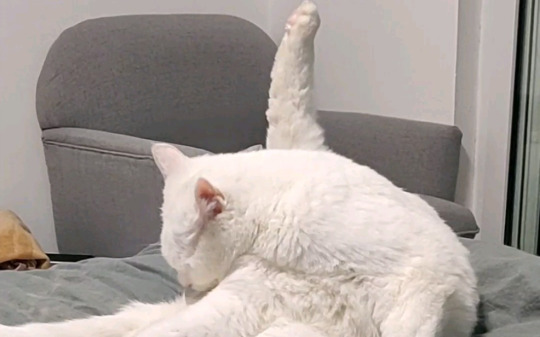
^ An inhabitant of Planet Meow sending signals back to its mother planet.
Another common internet slang for the act of kissing, sniffing, or hugging a cat out of adoration is “sniffing cat”/“吸猫”/ximao. As some might notice, the term subtly and playfully draws a parallel between the addictive aspect of cuddling with a cat and the addictiveness of illicit drugs. Finally, because 喵 (miāo), the character for “meow”, is a homophone of 妙 (miào), the character that can mean “great”, on videos where there are cats meowing clearly, you can see barrage comments from many people asking questions like “how is my exam going to go” or “how is my job interview going to go”, as a playful way of wishing for things to go smoothly in the near future.
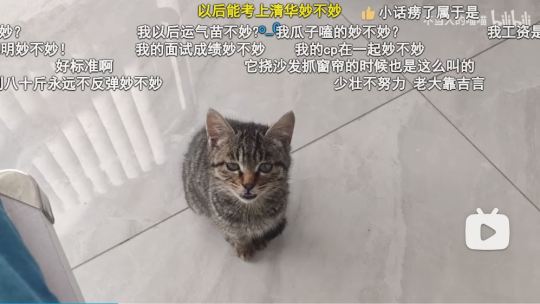
^ Some examples of these barrage comments, with people asking “how is my job interview score”, “how is my luck in the future”, “am I going to be accepted into Tsinghua University”. Video from Bilibili.
And that is all for the history of cats in China! In Part 3 and Part 4 I will cover famous paintings about cats and poems of cats, and these posts will be coming out within the next two weeks, stay tuned!
294 notes
·
View notes